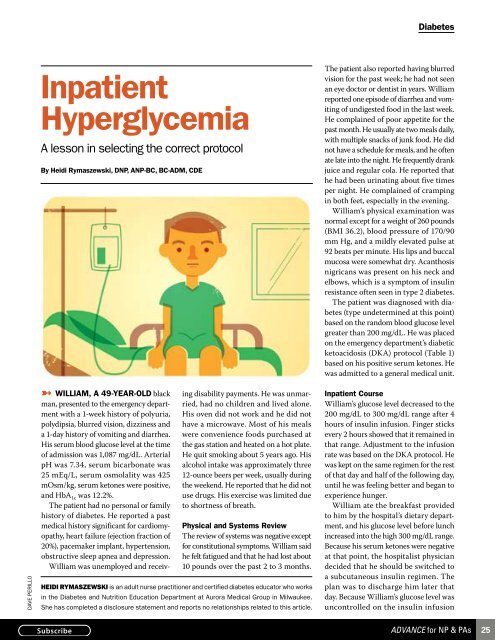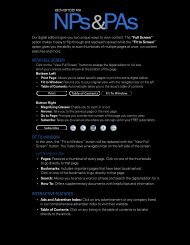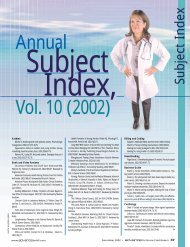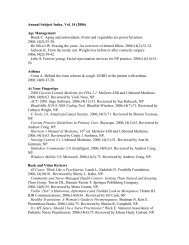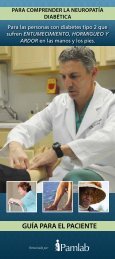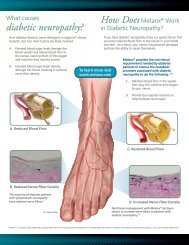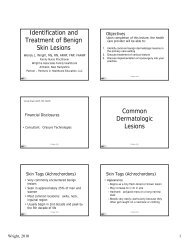View Full Screen - ADVANCE for NPs & PAs
View Full Screen - ADVANCE for NPs & PAs
View Full Screen - ADVANCE for NPs & PAs
Create successful ePaper yourself
Turn your PDF publications into a flip-book with our unique Google optimized e-Paper software.
Diabetes<br />
Dave Perillo<br />
Inpatient<br />
Hyperglycemia<br />
A lesson in selecting the correct protocol<br />
By Heidi Rymaszewski, DNP, ANP-BC, BC-ADM, CDE<br />
➼ William, a 49-year-old black<br />
man, presented to the emergency department<br />
with a 1-week history of polyuria,<br />
polydipsia, blurred vision, dizziness and<br />
a 1-day history of vomiting and diarrhea.<br />
His serum blood glucose level at the time<br />
of admission was 1,087 mg/dL. Arterial<br />
pH was 7.34, serum bicarbonate was<br />
25 mEq/L, serum osmolality was 425<br />
mOsm/kg, serum ketones were positive,<br />
and HbA 1c was 12.2%.<br />
The patient had no personal or family<br />
history of diabetes. He reported a past<br />
medical history significant <strong>for</strong> cardiomyopathy,<br />
heart failure (ejection fraction of<br />
20%), pacemaker implant, hypertension,<br />
obstructive sleep apnea and depression.<br />
William was unemployed and receiving<br />
disability payments. He was unmarried,<br />
had no children and lived alone.<br />
His oven did not work and he did not<br />
have a microwave. Most of his meals<br />
were convenience foods purchased at<br />
the gas station and heated on a hot plate.<br />
He quit smoking about 5 years ago. His<br />
alcohol intake was approximately three<br />
12-ounce beers per week, usually during<br />
the weekend. He reported that he did not<br />
use drugs. His exercise was limited due<br />
to shortness of breath.<br />
Physical and Systems Review<br />
The review of systems was negative except<br />
<strong>for</strong> constitutional symptoms. William said<br />
he felt fatigued and that he had lost about<br />
10 pounds over the past 2 to 3 months.<br />
Heidi Rymaszewski is an adult nurse practitioner and certified diabetes educator who works<br />
in the Diabetes and Nutrition Education Department at Aurora Medical Group in Milwaukee.<br />
She has completed a disclosure statement and reports no relationships related to this article.<br />
The patient also reported having blurred<br />
vision <strong>for</strong> the past week; he had not seen<br />
an eye doctor or dentist in years. William<br />
reported one episode of diarrhea and vomiting<br />
of undigested food in the last week.<br />
He complained of poor appetite <strong>for</strong> the<br />
past month. He usually ate two meals daily,<br />
with multiple snacks of junk food. He did<br />
not have a schedule <strong>for</strong> meals, and he often<br />
ate late into the night. He frequently drank<br />
juice and regular cola. He reported that<br />
he had been urinating about five times<br />
per night. He complained of cramping<br />
in both feet, especially in the evening.<br />
William’s physical examination was<br />
normal except <strong>for</strong> a weight of 260 pounds<br />
(BMI 36.2), blood pressure of 170/90<br />
mm Hg, and a mildly elevated pulse at<br />
92 beats per minute. His lips and buccal<br />
mucosa were somewhat dry. Acanthosis<br />
nigricans was present on his neck and<br />
elbows, which is a symptom of insulin<br />
resistance often seen in type 2 diabetes.<br />
The patient was diagnosed with diabetes<br />
(type undetermined at this point)<br />
based on the random blood glucose level<br />
greater than 200 mg/dL. He was placed<br />
on the emergency department’s diabetic<br />
ketoacidosis (DKA) protocol (Table 1)<br />
based on his positive serum ketones. He<br />
was admitted to a general medical unit.<br />
Inpatient Course<br />
William’s glucose level decreased to the<br />
200 mg/dL to 300 mg/dL range after 4<br />
hours of insulin infusion. Finger sticks<br />
every 2 hours showed that it remained in<br />
that range. Adjustment to the infusion<br />
rate was based on the DKA protocol. He<br />
was kept on the same regimen <strong>for</strong> the rest<br />
of that day and half of the following day,<br />
until he was feeling better and began to<br />
experience hunger.<br />
William ate the breakfast provided<br />
to him by the hospital’s dietary department,<br />
and his glucose level be<strong>for</strong>e lunch<br />
increased into the high 300 mg/dL range.<br />
Because his serum ketones were negative<br />
at that point, the hospitalist physician<br />
decided that he should be switched to<br />
a subcutaneous insulin regimen. The<br />
plan was to discharge him later that<br />
day. Because William’s glucose level was<br />
uncontrolled on the insulin infusion<br />
<strong>ADVANCE</strong> <strong>for</strong> NP & <strong>PAs</strong><br />
25


